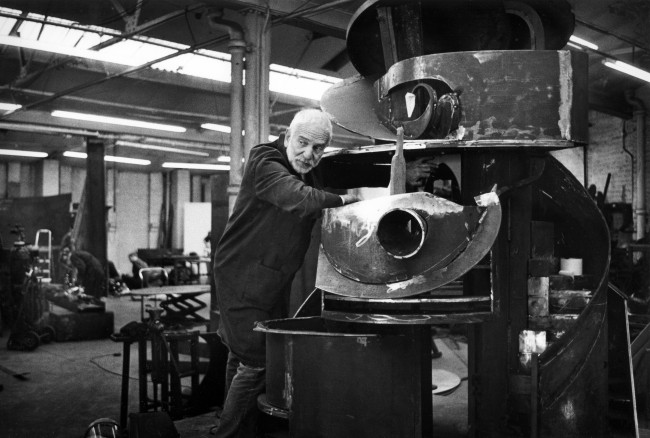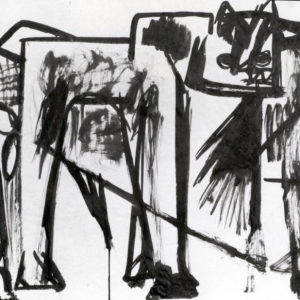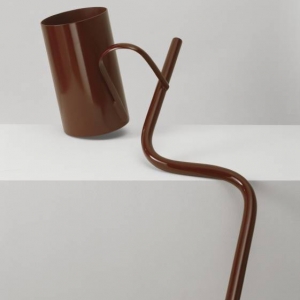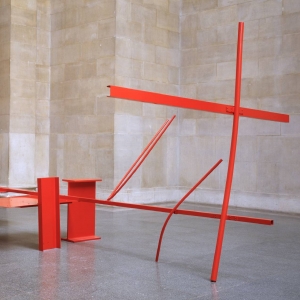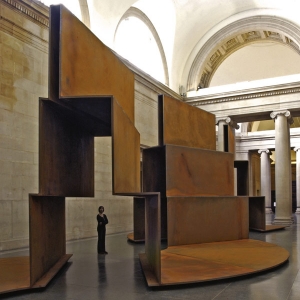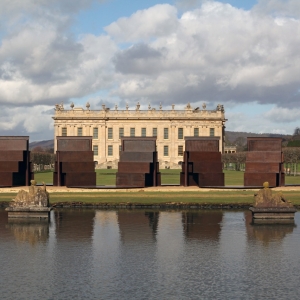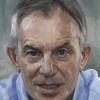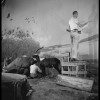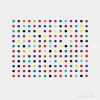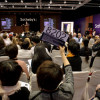Sir Anthony Caro, who died on 23 October 2013, was the greatest sculptor of his generation. An abstract artist whose work comprised assemblages of metal objects, including found material, he was known for his large scale pieces. His works, with their striking titles such as Early One Morning or Twenty-Four Hours? seem to balance in unlikely ways, with many often painted with solid banks of colour; his work has been likened to Picasso’s cubist collages. Caro retained a strong feeling of the importance of art to the spirit. On being asked by the journalist Alastair Sook what his sculpture was for, he replied “to please the eye and feed the soul”.
Anthony Caro was born in New Malden, London, the youngest child of a stock-broker. Educated at Charterhouse, he was introduced to the sculptor Charles Wheeler and worked in Wheeler’s studio during the school holidays. After a degree in Engineering at Cambridge and a period in the Royal Navy, he studied sculpture at the Regent Street Polytechnic and the Royal Academy Schools. The training at this period was still very traditional with the copying of sculptures from the antique, which bored Caro.
In the 1950’s Caro worked as an assistant to Henry Moore, where he was introduced to modernism. Caro’s own work at this time was largely figurative, and the change in his style arose thanks to two influences. The first was the American critic Clement Greenberg, who saw in Caro’s sculptures the three-dimensional equivalent of the abstract work being created in the USA at that time. Then in the early 1960’s, during a visit to the United States, on a Ford Foundation and English Speaking Union grant, Caro came into direct contact with the leading American artists of the time, notably the Abstract Expressionst sculptor David Smith who would become a friend and rival. This led Caro to abandon his earlier style and start constructing sculptures from prefabricated metal, welding and bolting pieces together.
His first solo exhibition was in 1956 at the Galleria de Naviglio in Milan, with his first solo London show the following year at Gimpel Fils Gallery. But, it was the 1963 exhibition at the Whitechapel Art Gallery that was responsible for giving wider currency to his change in direction and consolidating his reputation. Here he exhibited a group of steel structures, brightly coloured and exploding rather than being focused on a single point, and almost as radically they were placed directly on the floor.
The Museum of Modern Art in New York held a major retrospective of his work in 1975.
In 1980, Caro was trying to organise an exhibition of British abstract art in South Africa and met the English businessman and art collector Robert Loder. This ultimately led to the two setting up workshops for professional artists, the first being held in 1982 in White Plains, New York. The project became the Triangle Arts Trust.
The 1980s also saw Caro change direction in his own work. Having visited Greece in 1985 he embarked on a series of large scale narrative works, drawing on more literal elements in his work. After Olympia is a large scale panorama, 20 metres long, inspired by the temple of Zeus in Olympia.
In the 1990s he started developing large scale sculpture which incorporated architectural elements such as stairs and ramps, the idea arising from a workshop he gave with architect Frank Gehry in which the discussed the relationship between architecture and sculpture. His Tower of Discovery exhibited at the Tate in 1991 was a 13 metre steel tower, which proved an immense success and led to the commission for Sea Music; a large scale sculpture including a lookout platform for Poole harbour. He was also involved in the development of the new bridge across the Thames with Norman Foster and Chris Wise. One of his largest pieces was Goodwood Steps a pair of giant steel steps of rusting steel for Goodwod Park in 1996; at the time they were the largest sculptures in Britain. In 1999 he started work on a series of structures inspired by Duccio’s Annunciation (1311). Three works from this series of seven Duccio Variations made in different materials from steel and wood to iron and perspex were included in the Encounters exhibition at the National Gallery, London in 2000.
In 2004, for his 80th birthday, seven institutions in Baltimore, New York, Paris, London and Amsterdam, including the Tate Britain, held exhibitions of his work. Tate Britain’s 2005 retrospective covered all the principal phases of Caro’s work from the 1950s through to a new piece, Millbank Steps.
A long term project was his Chapel of Light installed in the choir of the 13th century Gothic Church of St. Jean-Baptiste, Bourbourg in Northern France, which had been badly damaged in the Second World War. This project started in 1999 and was completed in 2008. To accompany the opening, museums in Calais, Dunkirk and Gravelines in the Pas-de Calais, France held exhibitions, as well as exhibitions in Angers, Paris and Lille, making it Caro’s largest retrospective in France.
In 2011 the Metropolitan Museum of Art in New York installed five of Caro’s works on their rooftop, a setting which was outdoor yet metropolitan and suited Caro’s work far more than installation in natural surroundings. In 2012 the Yale Center for British Art presented Caro: Close Up in 2012. In summer 2013, in as part of the ‘Venice Biennale’ he exhibited at the Museo Correr in Venice, his first retrospective in Italy. This exhibition included what became his last work.
As a teacher, Caro taught at Bennington College from 1963 to 1965, and was an influential tutor at St Martin’s School of Art from the 1953 to the 1981 with former students and assistants including Philip King, Tim Scott, William G Tucker, Peter Hide, Robert Deacon, Barry Flanagan and Gilbert and George.
Caro married his wife Sheila (the painter Sheila Girling) in 1949 and she was an important influence on the colours Caro used for his sculptures.
Anthony Caro was knighted in 1987 and received the Order of Merit in 2000. He had refused offers to become an RA but in 2004 he became a Senior Member of the Royal Academy.
